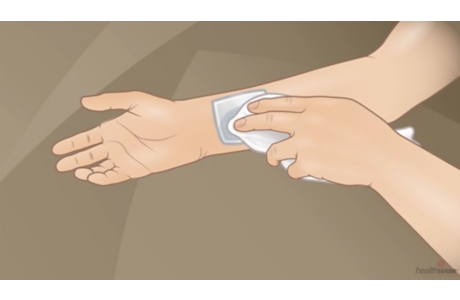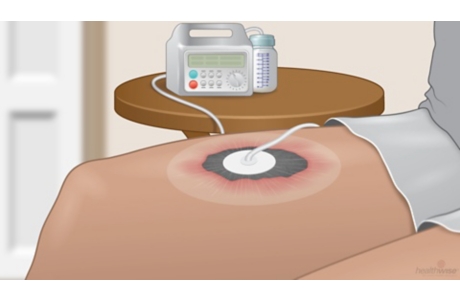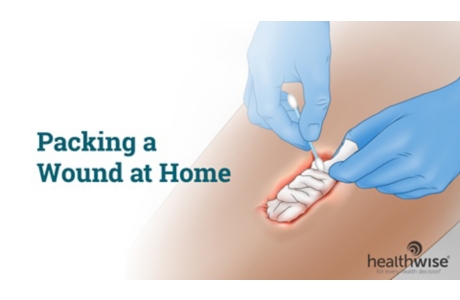Pressure Injuries
Topic Overview
What are pressure injuries?
A pressure injury on the skin is caused by constant pressure to that area. This often occurs when a person lies in bed or sits in a chair for a long time. Pressure reduces blood supply to the skin. Over time, this can cause the skin to break down and form an open sore. Pressure injuries are also called bed sores or pressure ulcers.
Pressure injuries can range from red areas on the surface of the skin to severe tissue damage that goes deep into muscle and bone. They usually form over bony areas such as the hips, lower back, elbows, and heels. They may also occur in places where the skin folds over itself or where medical equipment puts pressure on the skin, such as where oxygen tubing presses on the ears or cheeks.
Pressure injuries can be hard to treat and slow to heal. If they don’t heal properly, they can lead to problems such as skin infection or bone infection.
If you or someone you care for is not able to move much, it’s important to prevent sores and to check the skin every day. If you think a pressure injury is forming, take steps to treat it, and talk to your doctor or nurse about what more you can do.
What causes pressure injuries?
Things that cause pressure injuries include:
- Pressure on the skin and tissues. This is the most common cause.
- Sliding down in a bed or chair, which can cause the skin to fold over itself (shear force).
- Being pulled across bed sheets or other surfaces, which can cause friction burns.
- Excess moisture, such as from sweat, urine, or feces. Skin that is often wet is more likely to break down and form pressure injuries.
What increases the risk of getting pressure injuries?
Things that make a person more likely to get pressure injuries include:
- Not being able to move easily. This often happens because of a spinal injury, paralysis, coma, or surgery.
- Poor bladder or bowel control.
- Poor nutrition. A diet that doesn’t have enough protein can lead to unhealthy skin and slow healing.
- Decreased alertness, which may be due to a health problem or taking certain medicines. People who are not alert may not take the steps to prevent pressure injuries or understand why prevention is important.
- Aging. As people age, their skin becomes thinner, drier, and less elastic, so it is more easily injured.
- Smoking. Smoking dries out the skin and reduces blood flow to the skin.
- Having a health problem that interferes with healing, such as diabetes.
How are pressure injuries diagnosed?
A doctor can diagnose a pressure injury by examining it.
In some cases, a doctor may want to do tests such as:
- Blood tests to check for infection or to see if you are getting enough protein in your diet.
- A skin and wound culture, to identify germs that may be infecting the skin or wound.
- A skin biopsy, if the cause of a skin problem is unknown.
How are they treated?
Treatment focuses on preventing a sore from getting worse and on making the skin healthy again. These steps can help a pressure injury heal:
- Take pressure off the area. Change positions often. Spread body weight evenly with special mattresses, pads, or other support.
- Keep the sore clean and covered with a bandage. The doctor will tell you what type of bandage to use. You will probably be told to keep the wound a little moist and not let it dry out between bandage changes.
- Keep the healthy tissue around a pressure injury clean and dry.
- Eat a healthy diet with enough protein to help the skin heal.
To promote healing, your doctor may remove dead tissue from the wound. Bacteria can grow in dead tissue and cause infection. If you get an infection, you may need antibiotics.
Severe pressure injuries may be treated with surgery. For example, a skin graft may be done to help new skin grow at the site of a sore.
How can you prevent pressure injuries?
There are many things you can do to help prevent pressure injuries if you’re at risk. It’s also important to use these steps to help an existing sore heal. If you can’t do them yourself, ask a family member or friend for help.
Change position often
- In a bed, change position every 2 hours. Learn how to move yourself so that you avoid folding and twisting your skin.
- In a wheelchair or other type of chair, shift your weight every 15 minutes.
- Try not to slide or slump across sheets in a chair or bed. Recliner chairs are likely to allow slipping, so do not sleep in a recliner.
Take good care of your skin
- Keep your skin clean and free of sweat, urine, and feces. Wash with gentle soap and warm (not hot) water. Don’t scrub the skin too hard.
- If you have problems with bowel or bladder control, clean the skin right away. Use a barrier cream or lotion to protect your skin from moisture.
- If you have dry skin, use moisturizing cream or lotion to keep your skin from drying out and cracking.
- Know what pressure injuries look like, and check your skin every day. Pay special attention to bony areas, such as the hips, elbows, knees, and heels. Also check places where the skin folds over itself. Have someone else look at areas you can’t see.
Make healthy choices
- Eat healthy foods with enough protein, and get plenty of fluids. That can help damaged skin heal and help new skin grow.
- Stay at a healthy weight. Both weight gain and weight loss can make pressure injuries more likely.
- Don’t smoke. Smoking dries the skin and reduces its blood supply.
Talk to your doctor about pressure-relieving cushions and pads
- There are special pads to put on top of a mattress to help it fit your body’s shape better. And there are cushions that can reduce pressure on certain areas of the body.
- Ask your doctor which cushions and pads might help you. Some products, such as doughnut-type devices, may actually cause pressure injuries or make them worse.
References
Other Works Consulted
- Baranoski S, et al. (2012). Wound treatment options. In S Baranoski, EA Ayello, eds., Wound Care Essentials: Practice Principles, 3rd ed., pp. 181–239. Philadelphia: Lippincott Williams and Wilkins.
- Hyperbaric oxygen therapy for refractory wounds (2010). Medical Letter on Drugs and Therapeutics, 52(1333): 19–20.
- Powers JG, et al. (2012). Decubitus (pressure) ulcers. In LA Goldsmith et al., eds., Fitzpatrick’s Dermatology in General Medicine, 8th ed., vol. 1, pp. 1121–1129. New York: McGraw-Hill.
- Qaseem A, et al. (2015). Risk assessment and prevention of pressure ulcers: A clinical practice guideline from the American College of Physicians. Annals of Internal Medicine, 162(5): 359–369. DOI: 10.7326/M14-1567. Accessed April 9, 2015.
- Qaseem A, et al. (2015). Treatment of pressure ulcers: A clinical practice guideline from the American College of Physicians. Annals of Internal Medicine, 162(5): 370–379. DOI: 10.7326/M14-1568. Accessed April 9, 2015.
Current as of: September 26, 2018
Author: Healthwise Staff
Medical Review:E. Gregory Thompson, MD – Internal Medicine & Adam Husney, MD – Family Medicine & Kathleen Romito, MD – Family Medicine & Margaret M. Doucette, DO – Physical Medicine and Rehabilitation, Wound Care, Hyperbaric Medicine
This information does not replace the advice of a doctor. Healthwise, Incorporated, disclaims any warranty or liability for your use of this information. Your use of this information means that you agree to the Terms of Use. Learn how we develop our content.







